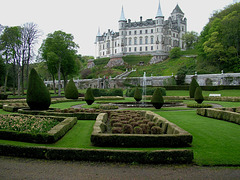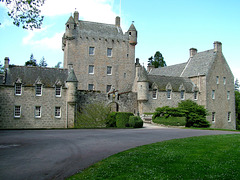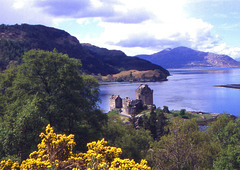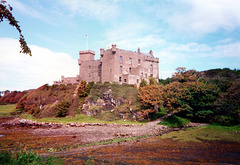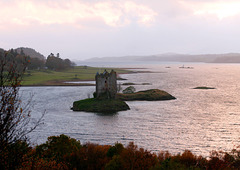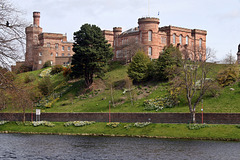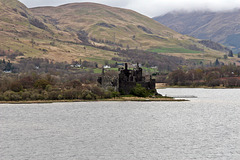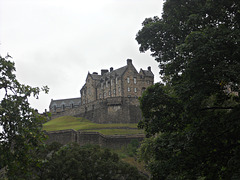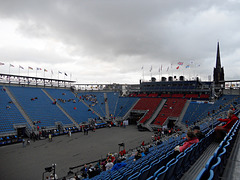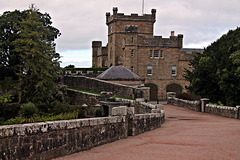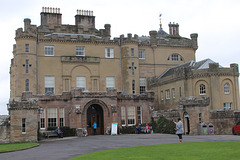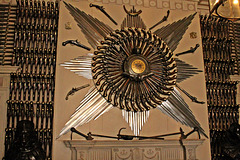
Castles
East front Dunrobin Castle and Gardens 15th May 20…
| |
|
|
|
Dunrobin Castle is a stately home in Sutherland, in the Highland area of Scotland, and the family seat of the Earl of Sutherland and the Clan Sutherland. It is located 1 mile (1.6 km) north of Golspie, and approximately 5 miles (8.0 km) south of Brora, overlooking the Dornoch Firth.
Dunrobin's origins lie in the Middle Ages, but most of the present building and the gardens were added by Sir Charles Barry between 1835 and 1850. Some of the original building is visible in the interior courtyard, despite a number of expansions and alterations that made it the largest house in the north of Scotland. After being used as a boarding school for seven years, it is now open to the public.
Cawdor Castle 18th May 2006
| |
|
|
|
CCawdor Castle is set amid gardens in the parish of Cawdor in Nairnshire, Scotland. The castle is built around a 15th-century tower house, with substantial additions in later centuries. Originally a property of the Calder family, it passed to the Campbells in the 16th century. It remains in Campbell ownership, and is now home to the Dowager Countess Cawdor, stepmother of Colin Campbell, 7th Earl Cawdor.
The castle is perhaps best known for its literary connection to William Shakespeare's tragedy Macbeth, in which the title character is made "Thane of Cawdor". However, the story is highly fictionalised, and the castle itself, which is never directly referred to in Macbeth, was built many years after the life of the 11th-century King Macbeth.
The castle is a category A listed building, and the grounds are included in the Inventory of Gardens and Designed Landscapes in Scotland, the national listing of significant gardens.
Eilean Donan Castle Loch Duich from the old Road D…
| |
|
|
|
Eilean Donan (Scottish Gaelic: Eilean Donnain) is a small tidal island where three sea lochs meet, Loch Duich, Loch Long and Loch Alsh, in the western Highlands of Scotland. A picturesque castle that frequently appears in photographs, film and television dominates the island, which lies about 1 kilometre (0.62 mi) from the village of Dornie. Since the castle's restoration in the early 20th century, a footbridge has connected the island to the mainland.
Eilean Donan is part of the Kintail National Scenic Area, one of 40 in Scotland.In 2001, the island had a recorded population of just one person,but there were no "usual residents" at the time of the 2011 census.
Eilean Donan, which means simply "island of Donnán", is named after Donnán of Eigg, a Celtic saint martyred in 617. Donnán is said to have established a church on the island, though no trace of this remains.
The castle was founded in the thirteenth century, and became a stronghold of the Clan Mackenzie and their allies the Clan Macrae. In the early eighteenth century, the Mackenzies' involvement in the Jacobite rebellions led in 1719 to the castle's destruction by government ships. Lieutenant-Colonel John Macrae-Gilstrap's twentieth-century reconstruction of the ruins produced the present buildings.
Dunvegan Castle,Isle of Skye
| |
|
Dunvegan Castle is a castle a mile and a half to the north of Dunvegan on the Isle of Skye, situated off the West coast of Scotland. It is the seat of the MacLeod of MacLeod, chief of the Clan MacLeod. Dunvegan Castle is the oldest continuously inhabited castle in Scotland and has been the stronghold of the chiefs of the clan for more than 800 years.
Dunvegan Castle occupies the summit of a rock which projects on to the eastern shore of an inlet and some 30 ft higher than the area around it and is 175 ft long and 110 ft wide.
It stands in a covered bay that faces North along the east side of the Inlet. Until recent centuries the sea surrounded this rock, but due to years of land infilling this is no longer the case. "There seems little doubt that the rock was the site of a dun of some island chief at an early date. The name is said to mean 'Began's Dun'. All traces of any prehistoric structure seem to have been swept away for the medieval works. On the landward side, the castle is isolated by a ditch, partly natural and partly artificial, about 60 ft in width and 18 ft in present depth. In the 13th century, after the annexation of the Western Isles by Alexander III in 1266, the summit of the rock was enclosed with a certain wall with an arched entrance, the seagate, from which steps led up to the platform area, the only entrance to the castle till 1748. In the second half of the 14th century, a keep, 48 ft by 35 ft, was built at the NE angle of the rock. Early in the 16th century, the Fairy Tower was added at the SE corner, and between these two towers extends Roderick Macleod of Macleod's(Sir Rory Mor) work, erected in 1623. The SW wing was built between 1684 and 1690. All these buildings have been altered by the 19th century transformation.
The castle displays extremely diverse and distinct architectural forms that span across many different time periods.
Castle Stalker,Appin,Loch Linnhe 2nd November 2010
| |
|
|
|
Castle Stalker (Scottish Gaelic: Caisteal an Stalcaire) is a four-story tower house or keep picturesquely set on a tidal islet on Loch Laich, an inlet off Loch Linnhe. It is about 1.5 miles (2.4 km) north-east of Port Appin, Argyll, Scotland, and is visible from the A828 road about midway between Oban and Glen Coe. The islet is accessible (with difficulty) from the shore at low tide. The name "Stalker" comes from the Gaelic Stalcaire, meaning "hunter" or "falconer".
In recent times, the castle was brought to fame by the Monty Python team, appearing in their film Monty Python and the Holy Grail.
The original castle was a small fort, built around 1320 by Clan MacDougall who were then Lords of Lorn. Around 1388 the Stewarts took over the Lordship of Lorn, and it is believed that they built the castle in its present form around the 1440s. The Stewart's relative King James IV of Scotland visited the castle, and a drunken bet around 1620 resulted in the castle passing to Clan Campbell. After changing hands between these clans a couple of times the Campbells finally abandoned the castle in about 1840, when it lost its roof. In 1908 the castle was bought by Charles Stewart of Achara, who carried out basic conservation work. In 1965 Lt. Col. D. R. Stewart Allward acquired the castle and over about ten years fully restored it. Castle Stalker remains in private ownership and is open to the public at selected times during the summer.
For the 2011 census the island on which the castle stands was classified by the National Records of Scotland as an inhabited island that "had no usual residents at the time of either the 2001 or 2011 censuses.
Inverness Castle 19th April 2017
| |
|
|
|
Inverness Castle (Scottish Gaelic: Caisteal Inbhir Nis) sits on a cliff overlooking the River Ness, in Inverness, Scotland. The red sandstone structure evident today was built in 1836 by architect William Burn. It is built on the site of an 11th-century defensive structure. Today, it houses Inverness Sheriff Court. There has been a castle at this site for many centuries. The castle itself is not currently open to the public, however a recent campaign has led to the creation of a working group to explore the possibility of doing so in the future. At present, only the castle grounds are open to the public.
A succession of castles has stood on this site since 1057.
The castle is said to have been built by Máel Coluim III of Scotland, after he had razed to the ground the castle in which Macbeth of Scotland according to much later tradition, murdered Máel Coluim's father Donnchad I of Scotland, and which stood on a hill around 1 km to the north-east. The first Inverness Castle was partially destroyed by King Robert I of Scotland
In 1428, James I, in his effort to bring the Highlanders to heel, summoned fifty clan chiefs to a parley at Inverness Castle. However, “where the Parliament was at the time sitting, they were one by one by order of the King arrested, ironed, and imprisoned in different apartments and debarred from having any communications with each other or with their followers.Several chiefs were executed on the spot. Among those arrested were Alexander, 3rd Lord of the Isles, and his mother, Mariota, Countess of Ross. Lord Alexander remained imprisoned for twelve months, after which he returned to Inverness with 10,000 men and burnt the town, though he failed to take the Castle.See: Siege of Inverness (1429).
The castle was occupied during the Raid on Ross in 1491.
In 1548 another castle with tower was completed by George Gordon, 4th Earl of Huntly (1514–1562). He was constable of the castle until 1562. The castle was later taken by the Clan Munro and Clan Fraser who supported Mary Queen of Scots during the Siege of Inverness (1562). Robert Mor Munro, 15th Baron of Foulis, chief of the Clan Munro was a staunch supporter and faithful friend of Mary Queen of Scots and he consequently was treated favourably by her son James VI.
George Buchanan states, that when the unfortunate princess went to Inverness in 1562 and found the gates of the castle shut against her; "as soon as they heard of their sovereign's danger, a great number of the most eminent Scots poured in around her, especially the Frasers and Munros, who were esteemed the most valiant of the clans inhabiting those countries in the north". These two clans took Inverness Castle for the Queen, which had refused her admission. The Queen later hanged the governor, a Gordon who had refused entry.
Another angle on Inverness Castle 19th April 2017
| |
|
Inverness Castle (Scottish Gaelic: Caisteal Inbhir Nis) sits on a cliff overlooking the River Ness, in Inverness, Scotland. The red sandstone structure evident today was built in 1836 by architect William Burn. It is built on the site of an 11th-century defensive structure. Today, it houses Inverness Sheriff Court. There has been a castle at this site for many centuries. The castle itself is not currently open to the public, however a recent campaign has led to the creation of a working group to explore the possibility of doing so in the future. At present, only the castle grounds are open to the public.
A succession of castles has stood on this site since 1057.
The castle is said to have been built by Máel Coluim III of Scotland, after he had razed to the ground the castle in which Macbeth of Scotland according to much later tradition, murdered Máel Coluim's father Donnchad I of Scotland, and which stood on a hill around 1 km to the north-east. The first Inverness Castle was partially destroyed by King Robert I of Scotland
In 1428, James I, in his effort to bring the Highlanders to heel, summoned fifty clan chiefs to a parley at Inverness Castle. However, “where the Parliament was at the time sitting, they were one by one by order of the King arrested, ironed, and imprisoned in different apartments and debarred from having any communications with each other or with their followers. Several chiefs were executed on the spot. Among those arrested were Alexander, 3rd Lord of the Isles, and his mother, Mariota, Countess of Ross. Lord Alexander remained imprisoned for twelve months, after which he returned to Inverness with 10,000 men and burnt the town, though he failed to take the Castle.See: Siege of Inverness (1429).
The castle was occupied during the Raid on Ross in 1491.
In 1548 another castle with tower was completed by George Gordon, 4th Earl of Huntly (1514–1562). He was constable of the castle until 1562. The castle was later taken by the Clan Munro and Clan Fraser who supported Mary Queen of Scots during the Siege of Inverness (1562). Robert Mor Munro, 15th Baron of Foulis, chief of the Clan Munro was a staunch supporter and faithful friend of Mary Queen of Scots and he consequently was treated favourably by her son James VI.
George Buchanan states, that when the unfortunate princess went to Inverness in 1562 and found the gates of the castle shut against her; "as soon as they heard of their sovereign's danger, a great number of the most eminent Scots poured in around her, especially the Frasers and Munros, who were esteemed the most valiant of the clans inhabiting those countries in the north". These two clans took Inverness Castle for the Queen, which had refused her admission. The Queen later hanged the governor, a Gordon who had refused entry.
Kilchurn Castle,Loch Awe 20th April 2017
| |
|
|
|
Kilchurn Castle is a ruined structure on a rocky peninsula at the northeastern end of Loch Awe, in Argyll and Bute, Scotland. It was first constructed in the mid-15th century as the base of the Campbells of Glenorchy, who extended both the castle and their territory in the area over the next 150 years. After the Campbells became Earls of Breadalbane and moved to Taymouth Castle, Kilchurn fell out of use and was in ruins by 1770. It is now in the care of Historic Environment Scotland and is open to the public in summer.
The Campbells of Glenorchy were the most powerful cadet branch of the Clan Campbell, and over two centuries from the 1430s came to dominate the central Highlands. The building of several castles, of which Kilchurn was the first, was a key part of their territorial expansion duing this period. Sir Colin Campbell, 1st of Glenorchy (died 1475), was a younger son of Duncan Campbell, 1st Lord Campbell, ancestor of the Earls of Argyll. Sir Colin was granted Glen Orchy and other lands by his father in 1432, and afterwards established Kilchurn around 1450.The first castle comprised the five-storey tower house, with a courtyard defended by an outer wall. At the time Kilchurn was on a small island scarcely larger than the castle itself, and would have been accessed via an underwater or low-lying causeway.
Sir Colin's son, Sir Duncan Campbell of Glenorchy, built the 'laich hall' - a single-storey dining hall built along the inside of the south curtain. Sir Duncan was one of the many Scottish nobles killed at the Battle of Flodden in 1513. During the second half of the 16th century, another Sir Colin Campbell, the 6th Laird (1499–1583), further improved the castle's accommodation by adding some chambers to the north of the tower house, and remodelling the parapet. This included the introduction of the circular corner turrets adorned by corbels.Sir Colin also constructed Balloch Castle (now Taymouth Castle) by Loch Tay, to consolidate the Campbell's territorial gains in Perthshire, which had been achieved largely at the expense of their former allies, the Clan MacGregor of Glenstrae.
Sir Duncan Campbell, (c.1550–1631), known as "Black Duncan", represented Argyll in the Scottish Parliament and was created a baronet, of Glenorchy in the County of Perth, in the Baronetage of Nova Scotia in 1625. Sir Duncan had the south range of the castle rebuilt and enlarged in 1614, and constructed a new range incorporating a chapel in the south-east part of the courtyard.The ambitious Black Duncan also began construction of Finlarig Castle at the west end of Loch Tay, and improved farmland around Finlarig, Kilchurn and Balloch Castles.
In 1681 Sir John Campbell, 5th Baronet, was created Earl of Breadalbane and Holland. He took advantage of the turbulence of the times, negotiating with Jacobite rebels at the same time as serving William III. In the 1690s he promoted a scheme to pacify the Highlands, and as part of this he began conversion of Kilchurn into a modern barracks, capable of housing 200 troops. His main addition was the three-storey L-shaped block along the north side. In 1714, on the death of Queen Anne, Breadalbane held a conference of Jacobites at Kilchurn, and he subsequently joined the Earl of Mar's Jacobite rising of 1715. Following the failure of the rising he returned home to find pro-government members of his household had turned Kinchurn and Finlarig over to Alexander Campbell of Fonab, to whom Breadalbane was obliged to surrender in February 1716. He remained under house arrest at Taymouth until his death the next year.Kilchurn was also used as a government garrison during the 1745 Jacobite rising.The Campbells attempted, unsuccessfully, to sell Kilchurn to the government after they moved in 1740 to the reconstructed Taymouth Castle. In 1760, the castle was badly damaged by lightning and was completely abandoned; the remains of a turret of a tower, still resting upside-down in the centre of the courtyard, attest to the violence of the storm. The castle was unroofed by 1770. J M W Turner painted the castle on one of his tours of Scotland in the early 19th century.In 1817 the water level in Loch Awe was altered, so that the castle now stands on a long peninsula. MacGibbon and Ross surveyed the castle in about 1887, after which restoration works appear to have altered some of the castle's original features.
The ruin is now in the care of Historic Environment Scotland, and is open to the public during the summer. Access is either by boat from Lochawe pier, or on foot from the A85 near Dalmally. The access is under the railway viaduct that crosses Loch Awe, and access is sometimes restricted by higher-than-usual levels of water in the loch, at which times the site effectively becomes a temporary island.The castle is a scheduled monument.
Stirling Castle 14th August 2012
| |
|
|
|
Edinburgh Castle from Princess Street 14th August…
| |
|
|
|
Edinburgh Castle is a historic fortress which dominates the skyline of the city of Edinburgh, Scotland, from its position on the Castle Rock. Archaeologists have established human occupation of the rock since at least the Iron Age (2nd century AD), although the nature of the early settlement is unclear. There has been a royal castle on the rock since at least the reign of David I in the 12th century, and the site continued to be a royal residence until 1633. From the 15th century the castle's residential role declined, and by the 17th century it was principally used as military barracks with a large garrison. Its importance as a part of Scotland's national heritage was recognised increasingly from the early 19th century onwards, and various restoration programmes have been carried out over the past century and a half. As one of the most important strongholds in the Kingdom of Scotland, Edinburgh Castle was involved in many historical conflicts from the Wars of Scottish Independence in the 14th century to the Jacobite rising of 1745. Research undertaken in 2014 identified 26 sieges in its 1100-year-old history, giving it a claim to having been "the most besieged place in Great Britain and one of the most attacked in the world".
Few of the present buildings pre-date the Lang Siege of the 16th century, when the medieval defences were largely destroyed by artillery bombardment. The most notable exceptions are St Margaret's Chapel from the early 12th century, which is regarded as the oldest building in Edinburgh,the Royal Palace and the early-16th-century Great Hall, although the interiors have been much altered from the mid-Victorian period onwards. The castle also houses the Scottish regalia, known as the Honours of Scotland and is the site of the Scottish National War Memorial and the National War Museum of Scotland. The British Army is still responsible for some parts of the castle, although its presence is now largely ceremonial and administrative. Some of the castle buildings house regimental museums which contribute to its presentation as a tourist attraction.
The castle, in the care of Historic Scotland, is Scotland's most-visited paid tourist attraction, with over 2 million visitors in 2017 and over 70% of leisure visitors to Edinburgh visiting the castle. As the backdrop to the Edinburgh Military Tattoo during the annual Edinburgh Festival the castle has become a recognisable symbol of Edinburgh and of Scotland.
The Royal Edinburg Military Tattoo. The Audience G…
| |
|
|
|
The Royal Edinburgh Military Tattoo is an annual series of military tattoos performed by British Armed Forces, Commonwealth and international military bands, and artistic performance teams on the esplanade of Edinburgh Castle in the capital of Scotland. The event is held each August as part of the Edinburgh Festival.
Culzean Castle, Ayrshire 9th September 2019
| |
|
|
|
Culzean Castle (/kʌˈleɪn/ kul-AYN, see yogh; Scots: Cullain) is a castle overlooking the Firth of Clyde, near Maybole, Carrick, on the Ayrshire coast of Scotland. It is the former home of the Marquess of Ailsa, the chief of Clan Kennedy, but is now owned by the National Trust for Scotland. The clifftop castle lies within the Culzean Castle Country Park and is opened to the public. Since 1972 and until recently, an illustration of the castle has featured on the reverse side of five pound notes issued by the Royal Bank of Scotland.
In 1945, the Kennedy family gave the castle and its grounds to the National Trust for Scotland (thus avoiding inheritance tax). In doing so, they stipulated that the apartment at the top of the castle be given to General of the Army Dwight D. Eisenhower in recognition of his role as Supreme Commander of the Allied Forces in Europe during the Second World War. The General first visited Culzean Castle in 1946 and stayed there four times, including once while President of the United States.
The Ayrshire (Earl of Carrick's Own) Yeomanry, a British Yeomanry cavalry regiment, was formed by The Earl of Cassillis at Culzean Castle in about 1794. On 24 June 1961, the regiment returned to the castle to be presented with its first guidon by General Sir Horatius Murray, KBE, CB, DSO.
The castle re-opened in April 2011 after a refurbishment funded by a gift in the will of American millionaire William Lindsay to the National Trust for Scotland. Lindsay, who had never visited Scotland, requested that a significant portion of his $4 million go towards Culzean.Lindsay was reportedly interested in Eisenhower's holidays at the castle.
Culzean Castle received 382,608 visitors in 2018.
Culzean Castle, Ayrshire 9th September 2019.
| |
|
|
Culzean Castle, Ayrshire 9th September 2019.
| |
|
|
|
Culzean Castle,Ayrshire 9th September 2019
| |
|
|
|
Culzean Castle,Ayrshire 9th September 2019.
| |
|
|
|
Culzean Castle, Ayrshire 9th September 2019.
| |
|
|
|
Kilchurn Castle from The Loch Awe Hotel 31st Decem…
| |
|
|
|
Kilchurn Castle (/kəlˈxuːrn/) is a ruined structure on a rocky peninsula at the northeastern end of Loch Awe, in Argyll and Bute, Scotland. It was first constructed in the mid-15th century as the base of the Campbells of Glenorchy, who extended both the castle and their territory in the area over the next 150 years. After the Campbells became Earls of Breadalbane and moved to Taymouth Castle, Kilchurn fell out of use and was in ruins by 1770. It is now in the care of Historic Environment Scotland and is open to the public in summer.
The Campbells of Glenorchy were the most powerful cadet branch of the Clan Campbell, and over two centuries from the 1430s came to dominate the central Highlands. The building of several castles, of which Kilchurn was the first, was a key part of their territorial expansion during this period.Sir Colin Campbell, 1st of Glenorchy (died 1475), was a younger son of Duncan Campbell, 1st Lord Campbell, ancestor of the Earls of Argyll. Sir Colin was granted Glen Orchy and other lands by his father in 1432, and afterwards established Kilchurn around 1450.The first castle comprised the five-storey tower house, with a courtyard defended by an outer wall. At the time Kilchurn was on a small island scarcely larger than the castle itself, and would have been accessed via an underwater or low-lying causeway.
Sir Colin's son, Sir Duncan Campbell of Glenorchy, built the 'laich hall' - a single-storey dining hall built along the inside of the south curtain. Sir Duncan was one of the many Scottish nobles killed at the Battle of Flodden in 1513. During the second half of the 16th century, another Sir Colin Campbell, the 6th Laird (1499–1583), further improved the castle's accommodation by adding some chambers to the north of the tower house, and remodelling the parapet. This included the introduction of the circular corner turrets adorned by corbels.[6] Sir Colin also constructed Balloch Castle (now Taymouth Castle) by Loch Tay, to consolidate the Campbell's territorial gains in Perthshire, which had been achieved largely at the expense of their former allies, the Clan MacGregor of Glenstrae.
Sir Duncan Campbell, (c.1550–1631), known as "Black Duncan", represented Argyll in the Scottish Parliament and was created a baronet, of Glenorchy in the County of Perth, in the Baronetage of Nova Scotia in 1625. Sir Duncan had the south range of the castle rebuilt and enlarged in 1614, and constructed a new range incorporating a chapel in the south-east part of the courtyard.The ambitious Black Duncan also began construction of Finlarig Castle at the west end of Loch Tay, and improved farmland around Finlarig, Kilchurn and Balloch Castles.
In 1681 Sir John Campbell, 5th Baronet, was created Earl of Breadalbane and Holland. He took advantage of the turbulence of the times, negotiating with Jacobite rebels at the same time as serving William III. In the 1690s he promoted a scheme to pacify the Highlands, and as part of this he began conversion of Kilchurn into a modern barracks, capable of housing 200 troops. His main addition was the three-storey L-shaped block along the north side. In 1714, on the death of Queen Anne, Breadalbane held a conference of Jacobites at Kilchurn, and he subsequently joined the Earl of Mar's Jacobite rising of 1715. Following the failure of the rising he returned home to find pro-government members of his household had turned Kinchurn and Finlarig over to Alexander Campbell of Fonab, to whom Breadalbane was obliged to surrender in February 1716. He remained under house arrest at Taymouth until his death the next year.[8] Kilchurn was also used as a government garrison during the 1745 Jacobite rising.The Campbells attempted, unsuccessfully, to sell Kilchurn to the government after they moved in 1740 to the reconstructed Taymouth Castle.
In 1760, the castle was badly damaged by lightning and was completely abandoned; the remains of a turret of a tower, still resting upside-down in the centre of the courtyard, attest to the violence of the storm. The castle was unroofed by 1770.[9] J M W Turner painted the castle on one of his tours of Scotland in the early 19th century.In 1817 the water level in Loch Awe was altered, so that the castle now stands on a long peninsula. MacGibbon and Ross surveyed the castle in about 1887, after which restoration works appear to have altered some of the castle's original features.
The ruin is now in the care of Historic Environment Scotland, and is open to the public during the summer. Access is either by boat from Lochawe pier, or on foot from the A85 near Dalmally. The access is under the railway viaduct that crosses Loch Awe, and access is sometimes restricted by higher-than-usual levels of water in the loch, which turn the site into a temporary island. The castle is a scheduled monument.
Jump to top
RSS feed- Latest items - Subscribe to the latest items added to this album
- ipernity © 2007-2024
- Help & Contact
|
Club news
|
About ipernity
|
History |
ipernity Club & Prices |
Guide of good conduct
Donate | Group guidelines | Privacy policy | Terms of use | Statutes | In memoria -
Facebook
Twitter

